
piecepackr is an R package designed to make
configurable board game graphics. It can be used with the ggplot2, grid, rayrender, rayvertex, and rgl graphics
packages to make board game diagrams, board game animations, and custom
Print
& Play layouts. By default it is configured to make piecepack game diagrams, animations, and “Print
& Play” layouts but can be configured to make graphics for other
board game systems as well.
The function game_systems() returns configurations for
multiple public domain game systems:
game_systems() returns a checkers1 and
checkers2 configuration which has checkered and lined
“boards” with matching checker “bits” in various sizes and colors.
library("piecepackr")
library("tibble")
df_board <- tibble(piece_side = "board_face", suit = 3, rank = 8,
x = 4.5, y = 4.5)
df_w <- tibble(piece_side = "bit_face", suit = 6, rank = 1,
x = rep(1:8, 2), y = rep(1:2, each=8))
df_b <- tibble(piece_side = "bit_face", suit = 1, rank = 1,
x = rep(1:8, 2), y = rep(7:8, each=8))
df <- rbind(df_board, df_w, df_b)
df$cfg <- "checkers1"
pmap_piece(df, envir=game_systems(), default.units="in", trans=op_transform, op_scale=0.5)
game_systems() returns a dice configuration
which can make standard 6-sided dice in six colors.
game_systems() returns seven different configurations
for double-18 dominoes:
dominoesdominoes_blackdominoes_bluedominoes_greendominoes_reddominoes_white (identical to
dominoes)dominoes_yellowlibrary("piecepackr")
library("tibble")
envir <- game_systems("dejavu")
df_dominoes <- tibble(piece_side = "tile_face", x=rep(4:1, 3), y=rep(2*3:1, each=4), suit=1:12, rank=7:18+1,
cfg = paste0("dominoes_", rep(c("black", "red", "green", "blue", "yellow", "white"), 2)))
df_tiles <- tibble(piece_side = "tile_back", x=5.5, y=c(2,4,6), suit=1:3, rank=1:3, cfg="piecepack")
df_dice <- tibble(piece_side = "die_face", x=6, y=0.5+1:6, suit=1:6, rank=1:6, cfg="dice")
df_coins1 <- tibble(piece_side = "coin_back", x=5, y=0.5+1:4, suit=1:4, rank=1:4, cfg="piecepack")
df_coins2 <- tibble(piece_side = "coin_face", x=5, y=0.5+5:6, suit=1:2, rank=1:2, cfg="piecepack")
df <- rbind(df_dominoes, df_tiles, df_dice, df_coins1, df_coins2)
pmap_piece(df, default.units="in", envir=envir, op_scale=0.5, trans=op_transform)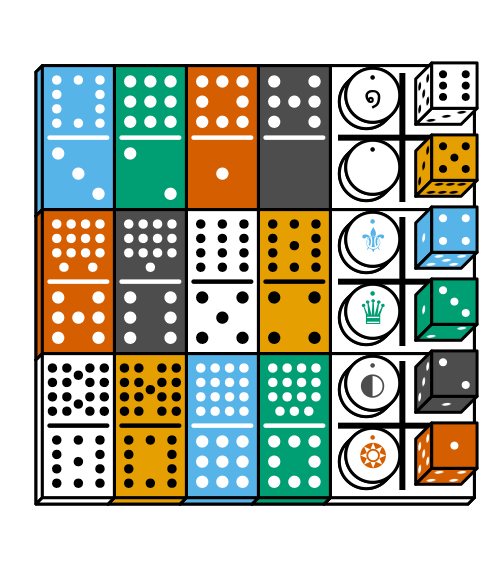
game_systems() returns a go configuration
for Go boards and
stones in a variety of colors and sizes. Here are is an example
diagram for a game of Multi-player
go plotted using rgl:
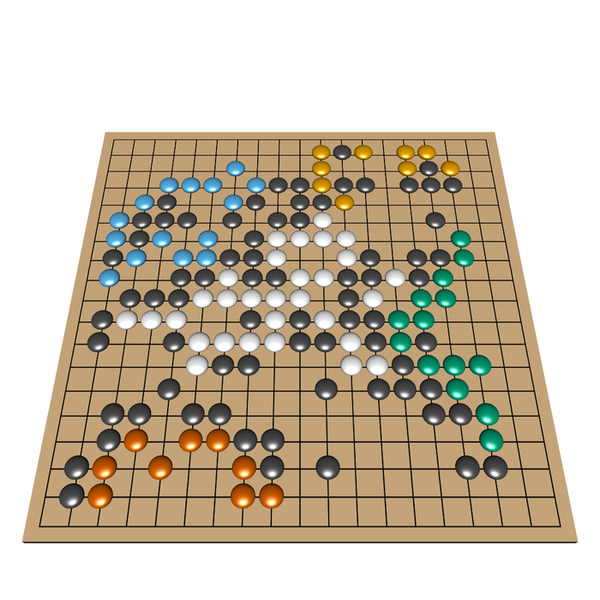
game_systems() returns three different piecepack configurations:
piecepackplaying_cards_expansiondual_piecepacks_expansionPlus a configuration for a subpack aka “mini” piecepack
and a hexpack configuration.
The piecepack configurations also contain common piecepack accessories like piecepack pyramids, piecepack matchsticks, and piecepack saucers.
game_systems() returns playing_cards,
playing_cards_colored, and playing_cards_tarot
(French Tarot) configurations for making diagrams with various decks of
playing cards.
library("piecepackr")
library("tibble")
envir <- game_systems("dejavu", round=TRUE)
df <- tibble(piece_side = "card_face",
x=1.25 + 2.5 * 0:3, y=2,
suit=1:4, rank=c(1,6,9,12),
cfg = "playing_cards")
pmap_piece(df, default.units="in", envir=envir)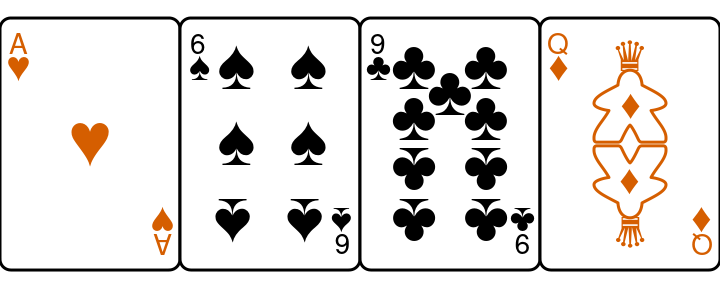
alquerque configuration that produces
“boards”/“bits” for Alquerque in a
variety of colors.chess1 and chess2 configurations with
checkered “boards” and matching chess “bits” (currently “disc” pieces
instead of “Staunton” pieces).dice_fudge configuration which can produce Fudge
dice in a variety of colors.meeples configuration that produces “meeple” bits in
a variety of colors.morris configuration that can produce Three/Six/Seven/Nine/Twelve
men’s morris “board”/“bits” in a variety of colors.reversi configuration that can produce
“boards”/“bits” for Reversi in a variety of
colors.Configurations for the proprietary Looney Pyramids aka Icehouse
Pieces game system by Andrew Looney can be found in the companion R
package piecenikr: https://github.com/piecepackr/piecenikr
grid.piece() is the core function that can used to draw
board game components (by default piecepack
game components) using grid:
library("piecepackr")
g.p <- function(...) { grid.piece(..., default.units="in") }
g.p("tile_back", x=0.5+c(3,1,3,1), y=0.5+c(3,3,1,1))
g.p("tile_back", x=0.5+3, y=0.5+1)
g.p("tile_back", x=0.5+3, y=0.5+1)
g.p("die_face", suit=3, rank=5, x=1, y=1)
g.p("pawn_face", x=1, y=4, angle=90)
g.p("coin_back", x=3, y=4, angle=180)
g.p("coin_back", suit=4, x=3, y=4, angle=180)
g.p("coin_back", suit=2, x=3, y=1, angle=90)
One can use lists
to configure to quickly adjust the appearance of the game components
drawn by grid.piece:
dark_colorscheme <- list(suit_color="darkred,black,darkgreen,darkblue,black",
invert_colors.suited=TRUE, border_color="black", border_lex=2)
piecepack_suits <- list(suit_text="\U0001f31e,\U0001f31c,\U0001f451,\u269c,\uaa5c", # 🌞,🌜,👑,⚜,꩜
suit_fontfamily="Noto Emoji,Noto Sans Symbols2,Noto Emoji,Noto Sans Symbols,Noto Sans Cham",
suit_cex="0.6,0.7,0.75,0.9,0.9")
traditional_ranks <- list(use_suit_as_ace=TRUE, rank_text=",a,2,3,4,5")
cfg <- c(piecepack_suits, dark_colorscheme, traditional_ranks)
g.p <- function(...) { grid.piece(..., default.units="in", cfg=pp_cfg(cfg)) }
g.p("tile_back", x=0.5+c(3,1,3,1), y=0.5+c(3,3,1,1))
g.p("tile_back", x=0.5+3, y=0.5+1)
g.p("tile_back", x=0.5+3, y=0.5+1)
g.p("die_face", suit=3, rank=5, x=1, y=1)
g.p("pawn_face", x=1, y=4, angle=90)
g.p("coin_back", x=3, y=4, angle=180)
g.p("coin_back", suit=4, x=3, y=4, angle=180)
g.p("coin_back", suit=2, x=3, y=1, angle=90)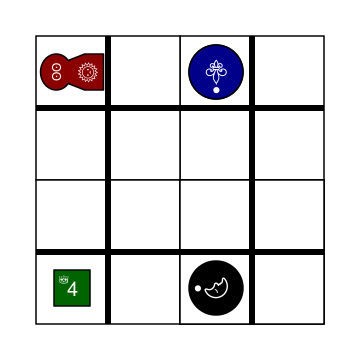
One can even specify custom
grob functions to completely customize the appearance of one’s game
pieces. piecepackr comes with a variety
of convenience functions such as pp_shape() to facilitate creating custom game
pieces. Here is an example of creating “patterned” checkers using
pp_shape() objects’ pattern() method powered
by the suggested package gridpattern:
library("grid")
library("gridpattern")
tilings <- c("hexagonal", "snub_square", "pythagorean",
"truncated_square", "triangular", "trihexagonal")
patternedCheckerGrobFn <- function(piece_side, suit, rank, cfg) {
opt <- cfg$get_piece_opt(piece_side, suit, rank)
shape <- pp_shape(opt$shape, opt$shape_t, opt$shape_r, opt$back)
gp_pattern <- gpar(col=opt$suit_color, fill=c(opt$background_color, "white"))
pattern_grob <- shape$pattern("polygon_tiling", type = tilings[suit],
spacing = 0.3, name = "pattern",
gp = gp_pattern, angle = 0)
gp_border <- gpar(col=opt$border_color, fill=NA, lex=opt$border_lex)
border_grob <- shape$shape(gp=gp_border, name = "border")
grobTree(pattern_grob, border_grob)
}
checkers1 <- as.list(game_systems()$checkers1)
checkers1$grob_fn.bit <- patternedCheckerGrobFn
checkers1 <- pp_cfg(checkers1)
x1 <- c(1:3, 1:2, 1)
x2 <- c(6:8, 7:8, 8)
df <- tibble::tibble(piece_side = c("board_face", rep_len("bit_back", 24L)),
suit = c(6L, rep(c(1L, 3L, 4L, 5L), each = 6L)),
rank = 8L,
x = c(4.5, x1, rev(x1), x2, rev(x2)),
y = c(4.5, rep(c(1,1,1, 2,2, 3, 6, 7,7, 8,8,8), 2)))
pmap_piece(df, cfg=checkers1, default.units="in")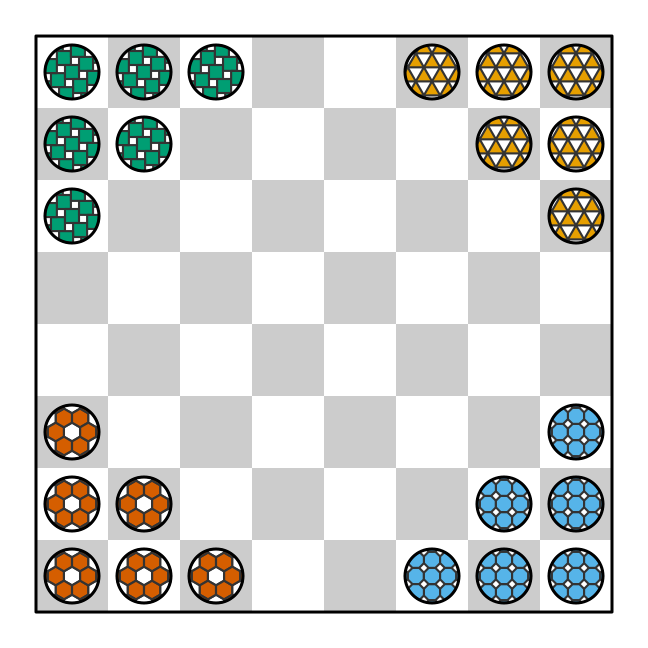
grid.piece even has some support for drawing 3D diagrams
with an oblique
projection:
cfg3d <- list(width.pawn=0.75, height.pawn=0.75, depth.pawn=1,
dm_text.pawn="", shape.pawn="convex6", invert_colors.pawn=TRUE,
edge_color.coin="tan", edge_color.tile="tan")
cfg <- pp_cfg(c(cfg, cfg3d))
g.p <- function(...) {
grid.piece(..., op_scale=0.5, op_angle=45, cfg=cfg, default.units="in")
}
g.p("tile_back", x=0.5+c(3,1,3,1), y=0.5+c(3,3,1,1))
g.p("tile_back", x=0.5+3, y=0.5+1, z=1/4+1/8)
g.p("tile_back", x=0.5+3, y=0.5+1, z=2/4+1/8)
g.p("die_face", suit=3, rank=5, x=1, y=1, z=1/4+1/4)
g.p("pawn_face", x=1, y=4, z=1/4+1/2, angle=90)
g.p("coin_back", x=3, y=4, z=1/4+1/16, angle=180)
g.p("coin_back", suit=4, x=3, y=4, z=1/4+1/8+1/16, angle=180)
g.p("coin_back", suit=2, x=3, y=1, z=3/4+1/8, angle=90)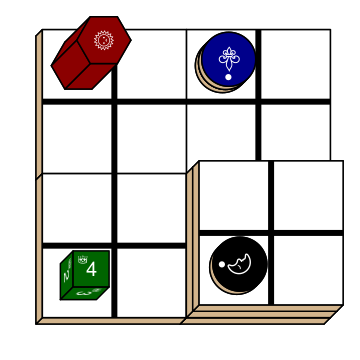
save_print_and_play() makes a “Print & Play” pdf of
a configured piecepack, save_piece_images() makes
individual images of each piecepack component:
save_print_and_play(cfg, "my_piecepack.pdf", size="letter")
save_piece_images(cfg)If you are comfortable using R data frames there is also
pmap_piece() that processes data frame input. It accepts an
optional trans argument for a function to pre-process the
data frames, in particular if desiring to draw a 3D oblique
projection one can use the function op_transform() to
guess both the pieces’ z-coordinates and an appropriate re-ordering of
the data frame given the desired angle of the oblique projection.
library("dplyr", warn.conflicts=FALSE)
library("tibble")
df_tiles <- tibble(piece_side="tile_back", x=0.5+c(3,1,3,1,1,1), y=0.5+c(3,3,1,1,1,1))
df_coins <- tibble(piece_side="coin_back", x=rep(1:4, 4), y=rep(c(4,1), each=8),
suit=1:16%%2+rep(c(1,3), each=8),
angle=rep(c(180,0), each=8))
df <- bind_rows(df_tiles, df_coins)
cfg <- game_systems("dejavu")$piecepack
pmap_piece(df, cfg=cfg, default.units="in", trans=op_transform, op_scale=0.5, op_angle=135)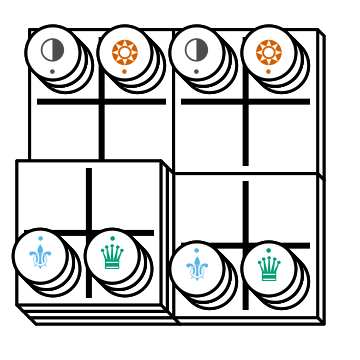
geom_piece() creates ggplot2 “geom” objects.
library("ggplot2")
envir <- game_systems("sans")
df_board <- tibble(piece_side = "board_face", suit = 3, rank = 12,
x = 4, y = 4)
df_b <- tibble(piece_side = "bit_face", suit = 2, rank = 1,
x = c(2, 3, 3, 4, 4), y = c(6, 5, 4, 5, 2))
df_w <- tibble(piece_side = "bit_face", suit = 1, rank = 1,
x = c(2, 2, 3, 4, 5, 5), y = c(4, 3, 6, 5, 4, 6))
df <- rbind(df_board, df_w, df_b)
ggplot(df, aes_piece(df)) +
geom_piece(cfg = "morris", envir = envir) +
coord_fixed() +
scale_x_piece(limits = c(0.5, 7.5)) +
scale_y_piece(limits = c(0.5, 7.5)) +
theme_minimal(32) +
theme(panel.grid = element_blank())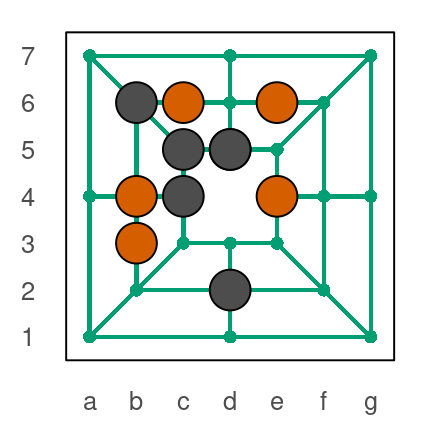
library("ppgames") # remotes::install_github("piecepackr/ppgames")
library("withr")
new <- list(piecepackr.cfg = "piecepack",
piecepackr.envir = game_systems("dejavu", pawn="joystick"),
piecepackr.op_angle = 90,
piecepackr.op_scale = 0.80)
dfc <- ppgames::df_fujisan(seed = 42)
withr::with_options(new, {
dft <- op_transform(dfc, as_top = "pawn_face", cfg_class = "character")
ggplot(dft, aes_piece(dft)) + geom_piece() + coord_fixed() + theme_void()
})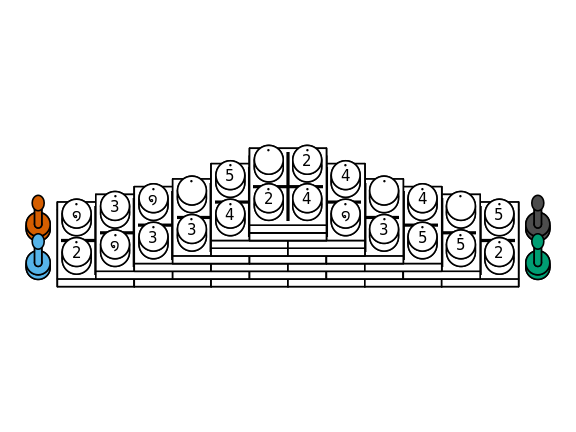
piece3d() draws pieces using rgl graphics.
library("piecenikr") # remotes::install_github("piecepackr/piecenikr")
library("rgl")
invisible(rgl::open3d())
rgl::view3d(phi=-45, zoom = 0.9)
df <- piecenikr::df_martian_chess()
envir <- c(piecenikr::looney_pyramids(), game_systems("sans3d"))
pmap_piece(df, piece3d, trans=op_transform, envir = envir, scale = 0.98, res = 150)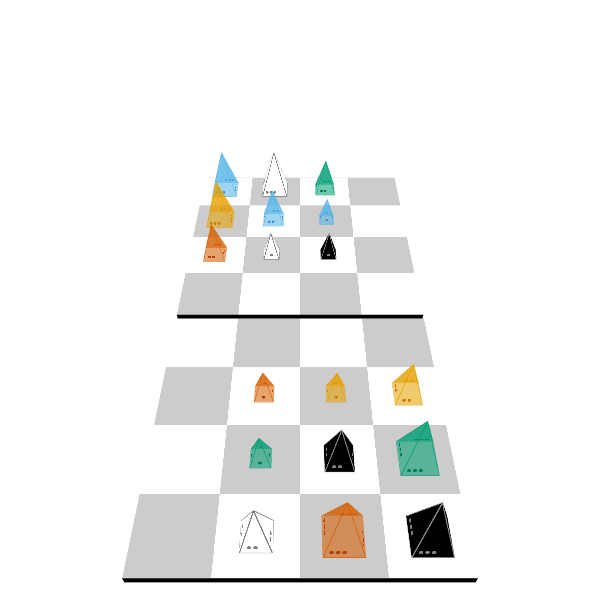
piece() creates rayrender objects.
library("ppgames") # remotes::install_github("piecepackr/ppgames")
library("magrittr")
library("rayrender", warn.conflicts = FALSE)
df <- ppgames::df_xiangqi()
envir <- game_systems("dejavu3d", round=TRUE, pawn="peg-doll")
l <- pmap_piece(df, piece, trans=op_transform, envir = envir, scale = 0.98, res = 150, as_top="pawn_face")
table <- sphere(z=-1e3, radius=1e3, material=diffuse(color="green")) %>%
add_object(sphere(x=5,y=-4, z=30, material=light(intensity=420)))
scene <- Reduce(rayrender::add_object, l, init=table)
rayrender::render_scene(scene, lookat = c(5, 5, 0), lookfrom = c(5, -7, 25),
width = 500, height = 500, samples=200, clamp_value=8)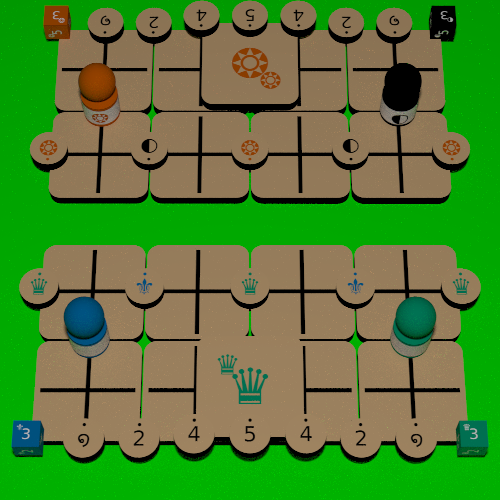
piece_mesh() creates rayvertex objects.
library("ppgames") # remotes::install_github("piecepackr/ppgames")
library("rayvertex", warn.conflicts = FALSE) # masks `rayrender::r_obj`
df <- ppgames::df_international_chess()
envir <- game_systems("dejavu3d", round=TRUE, pawn="joystick")
l <- pmap_piece(df, piece_mesh, trans=op_transform, envir = envir, scale = 0.98, res = 150, as_top="pawn_face")
table <- sphere_mesh(c(0, 0, -1e3), radius=1e3, material = material_list(diffuse="grey40"))
scene <- Reduce(rayvertex::add_shape, l, init=table)
rayvertex::rasterize_scene(scene, lookat = c(4.5, 4, 0), lookfrom=c(4.5, -16, 20),
light_info = directional_light(c(5, -7, 7), intensity = 2.5))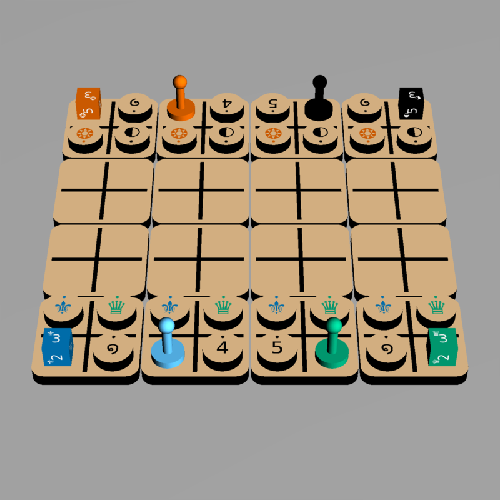
animate_piece() creates animations.
library("gifski")
library("piecepackr")
library("ppgames") # remotes::install_github("piecepackr/ppgames")
library("tweenr")
envir <- game_systems("dejavu")
cfg <- as.list(envir$piecepack)
cfg$suit_color <- "black"
cfg$background_color.r1 <- "#E69F00"
cfg$background_color.r2 <- "#56B4E9"
cfg$background_color.r3 <- "#009E73"
cfg$background_color.r4 <- "#F0E442"
cfg$background_color.r5 <- "#D55E00"
cfg$background_color.r6 <- "#F079A7"
envir$piecepack <- pp_cfg(cfg)
ppn_file <- system.file("ppn/relativity.ppn", package = "ppgames")
game <- read_ppn(ppn_file)[[1]]
animate_piece(game$dfs, file = "man/figures/README-relativity.gif", annotate = FALSE,
envir = envir, trans = op_transform, op_scale = 0.5,
n_transitions = 3, n_pauses = 2, fps = 7)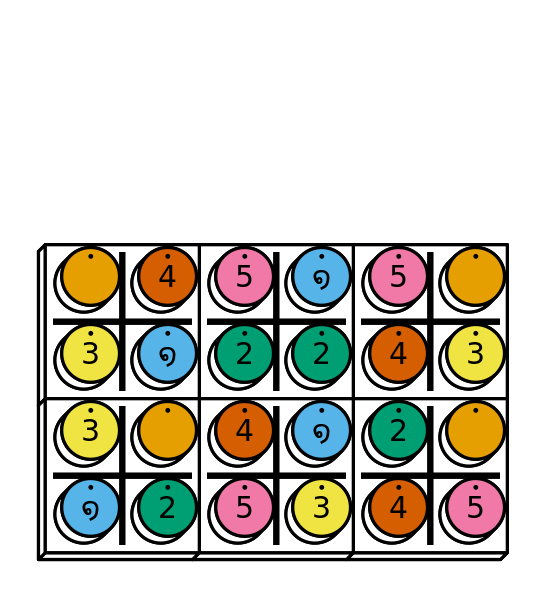
A slightly longer intro to piecepackr’s API plus several piecepackr demos and other piecpackr docs are available at piecepackr’s companion website as well as some pre-configured Print & Play PDFs. More API documentation is also available in the package’s built-in man pages.
Here we’ll show an example of configuring piecepackr to draw diagrams for the abstract board game Tak (designed by James Ernest and Patrick Rothfuss).
Since one often plays Tak on differently sized boards one common Tak board design is to have boards made with colored cells arranged in rings from the center plus extra symbols in rings placed at the points so it is easy to see smaller sub-boards. To start we’ll write a function to draw the Tak board.
library("grid", warn.conflicts=FALSE)
library("piecepackr")
grobTakBoard <- function(...) {
g <- "darkgreen"
w <- "grey"
fill <- c(rep(g, 5),
rep(c(g, rep(w, 3), g),3),
rep(g, 5))
inner <- rectGrob(x = rep(1:5, 5), y = rep(5:1, each=5),
width=1, height=1, default.units="in",
gp=gpar(col="gold", fill=fill, lwd=3))
outer <- rectGrob(gp=gpar(col="black", fill="grey", gp=gpar(lex=2)))
circles <- circleGrob(x=0.5+rep(1:4, 4), y=0.5+rep(4:1, each=4), r=0.1,
gp=gpar(col=NA, fill="gold"), default.units="in")
rects <- rectGrob(x=0.5+c(0:5, rep(c(0,5), 4), 0:5),
y=0.5+c(rep(5,6), rep(c(4:1), each=2), rep(0, 6)),
width=0.2, height=0.2,
gp=gpar(col=NA, fill="orange"), default.units="in")
grobTree(outer, inner, circles, rects)
}Then we’ll configure a Tak set and write some helper functions to draw Tak pieces with it.
cfg <- pp_cfg(list(suit_text=",,,", suit_color="white,tan4,", invert_colors=TRUE,
ps_text="", dm_text="",
width.board=6, height.board=6, depth.board=1/4,
grob_fn.board=grobTakBoard,
width.r1.bit=0.6, height.r1.bit=0.6, depth.r1.bit=1/4, shape.r1.bit="rect",
width.r2.bit=0.6, height.r2.bit=1/4, depth.r2.bit=0.6, shape.r2.bit="rect",
width.pawn=0.5, height.pawn=0.5, depth.pawn=0.8, shape.pawn="circle",
edge_color="white,tan4", border_lex=2,
edge_color.board="tan", border_color.board="black"))
g.p <- function(...) {
grid.piece(..., op_scale=0.7, op_angle=45, cfg=cfg, default.units="in")
}
draw_tak_board <- function(x, y) {
g.p("board_back", x=x+0.5, y=y+0.5)
}
draw_flat_stone <- function(x, y, suit=1) {
z <- 1/4*seq(along=suit)+1/8
g.p("bit_back", x=x+0.5, y=y+0.5, z=z, suit=suit, rank=1)
}
draw_standing_stone <- function(x, y, suit=1, n_beneath=0, angle=0) {
z <- (n_beneath+1)*1/4+0.3
g.p("bit_back", x=x+0.5, y=y+0.5, z=z, suit=suit, rank=2, angle=angle)
}
draw_capstone <- function(x, y, suit=1, n_beneath=0) {
z <- (n_beneath+1)*1/4+0.4
g.p("pawn_back", x=x+0.5, y=y+0.5, z=z, suit=suit)
}Then we’ll draw an example Tak game diagram:
pushViewport(viewport(width=inch(6), height=inch(6)))
draw_tak_board(3, 3)
draw_flat_stone(1, 1, 1)
draw_flat_stone(1, 2, 2)
draw_flat_stone(2, 4, 1)
draw_capstone(2, 4, 2, n_beneath=1)
draw_flat_stone(2, 5, 2)
draw_flat_stone(3, 4, 1:2)
draw_flat_stone(3, 3, c(2,1,1,2))
draw_flat_stone(3, 2, 1:2)
draw_flat_stone(3, 1, 2)
draw_standing_stone(4, 2, 2, angle=90)
draw_flat_stone(5, 2, 1)
draw_capstone(5, 3, 1)
popViewport()
To install the last version released on CRAN use the following command in R:
install.packages("piecepackr")To install the development version use the following commands:
install.packages("remotes")
remotes::install_github("piecepackr/piecepackr")Although the “core” {piecepackr} functionality does not
need any additional software installed some non-“core” functionality
needs extra suggested software to be installed. To install
all of the suggested R packages use:
install.packages("piecepackr", dependencies = TRUE)or (for the development version):
install.packages("remotes")
remotes::install_github("piecepackr/piecepackr", dependencies = TRUE)Suggested R packages:
animation
animate_piece() uses the {animation} package
to save “html” and “video” (e.g. mp4 and avi) animations. Additionally,
if the {gifski} package is not installed
animate_piece() will fall back to using
{animation} to make “gif” animations.
ggplot2
Required by the {ggplot2} bindings
geom_piece() and its helper functions
aes_piece(), scale_x_piece(), and
scale_y_piece().
gifski
animate_piece() uses the {gifski} package to
save “gif” animations.
gridpattern
The pp_shape() object’s pattern() method uses
{gridpattern} to make patterned shapes. In particular can
be used to make patterned board game pieces.
magick
file2grob() uses magick::image_read() to
import images that are not “png”, “jpg/jpeg”, or “svg/svgz”.
rayrender
Required for the {rayrender} binding piece()
and the pp_cfg() object’s rayrender_fn()
method.
rayvertex
Required for the {rayvertex} binding
piece_mesh() and the pp_cfg() object’s
rayvertex_fn() method.
readobj
Allows the {rgl} bindings to support more game piece
shapes; in particular the “meeple”, “halma”, and “roundrect” shaped
token game pieces.
rgl
Required for the {rgl} binding piece3d() and
the pp_cfg() object’s rgl_fn() method. Also
required for the obj_fn() method for game pieces with
ellipsoid shapes (in particular this may effect
save_piece_obj(), piece(),
piece3d(), and/or piece_mesh() when used with
the go stones and joystick pawns provided by
game_systems()). You may need to install
extra software for {rgl} to support OpenGL (in addition
to WebGL).
systemfonts
has_font() preferably uses {systemfonts} to
determine if a given font is available. If {styemfonts} is
not available it can fall back on the system tool pdffonts
if capabilities("cairo") == TRUE.
tweenr
animate_piece() needs {tweenr} to do animation
transitions (i.e. its n_transitions argument is greater
than the default zero).
The default piecepackr pp_cfg() configuration and the
default game systems returned by game_systems() should work
out on the box on most modern OSes including Windows without the user
needing to mess with their system fonts. However
game_systems(style = "dejavu") requires that the Dejavu Sans font
is installed.
For more advanced {piecepackr} configurations you’ll
want to install additional Unicode fonts and Windows users are highly
recommended to use and install piecepackr on “Ubuntu on Bash on Windows”
if planning on using Unicode symbols from multiple fonts. The following
bash commands will give you a good selection of fonts (Noto, Quivira,
and Dejavu) on Ubuntu:
sudo apt install fonts-dejavu fonts-noto
fonts_dir=${XDG_DATA_HOME:="$HOME/.local/share"}/fonts
curl -O http://www.quivira-font.com/files/Quivira.otf
mv Quivira.otf $fonts_dir/
curl -O https://noto-website-2.storage.googleapis.com/pkgs/NotoEmoji-unhinted.zip
unzip NotoEmoji-unhinted.zip NotoEmoji-Regular.ttf
mv NotoEmoji-Regular.ttf $fonts_dir/
rm NotoEmoji-unhinted.zipNote piecepackr works best if the
version of R installed was compiled with support for Cairo and
fortunately this is typically the case. One can confirm if this is true
via R’s capabilities function:
> capabilities("cairo")
cairo
TRUEAlso although most users won’t need them piecpackr
contains utility functions that depend on the system dependencies
ghostscript and poppler-utils:
save_print_and_play() will embed additional metadata
into the pdf if ghostscript is available.get_embedded_font() (a debugging helper function) needs
pdffonts (usually found in poppler-utils). If
the suggeste R package {systemfonts} is not installed then
has_font() also needs pdffonts.You can install these utilities on Ubuntu with
sudo apt install ghostscript poppler-utilsThe code of this software package is licensed under the MIT license.
Graphical assets generated using configurations returned by
game_systems() should be usable without attribution:
However, third party game configurations may be encumbered by copyright / trademark issues.
Some of R’s graphic devices (cairo_pdf(),
svg(), and png()) use Cairo which
uses fontconfig to select fonts. fontconfig
picks what it thinks is the ‘best’ font and sometimes it annoyingly
decides that the font to use for a particular symbol is not the one you
asked it to use (although sometimes the symbol it chooses instead still
looks nice in which case maybe you shouldn’t sweat it). It is hard but
not impossible to configure
which fonts are dispatched by fontconfig. A perhaps easier way to
guarantee your symbols will be dispatched would be to either make a new
font and re-assign the symbols to code points in the Unicode “Private
Use Area” that aren’t used by any other font on your system or to simply
temporarily move (or permanently delete) from your system font folders
the undesired fonts that fontconfig chooses over your
requested fonts:
# temporarily force fontconfig to use Noto Emoji instead of Noto Color Emoji in my piecepacks on Ubuntu 18.04
$ sudo mv /usr/share/fonts/truetype/noto/NotoColorEmoji.ttf ~/
## Make some piecepacks
$ sudo mv ~/NotoColorEmoji.ttf /usr/share/fonts/truetype/noto/Also as a sanity check use the command-line tool
fc-match (or the R function
systemfonts::match_font()) to make sure you specified your
font correctly in the first place
(i.e. fc-match "Noto Sans" on my system returns “Noto Sans”
but fc-match "Sans Noto" returns “DejaVu Sans” and not
“Noto Sans” as one may have expected). To help determine which fonts are
actually being embedded you can use the get_embedded_font()
helper function:
fonts <- c('Noto Sans Symbols2', 'Noto Emoji', 'sans')
chars <- c('♥', '♠', '♣', '♦', '🌞' ,'🌜' ,'꩜')
get_embedded_font(fonts, chars)
# char requested_font embedded_font
# 1 ♥ Noto Sans Symbols2 NotoSansSymbols2-Regular
# 2 ♠ Noto Sans Symbols2 NotoSansSymbols2-Regular
# 3 ♣ Noto Sans Symbols2 NotoSansSymbols2-Regular
# 4 ♦ Noto Sans Symbols2 NotoSansSymbols2-Regular
# 5 🌞Noto Sans Symbols2 NotoEmoji
# 6 🌜Noto Sans Symbols2 NotoEmoji
# 7 ꩜ Noto Sans Symbols2 NotoSansCham-Regular
# 8 ♥ Noto Emoji NotoEmoji
# 9 ♠ Noto Emoji NotoEmoji
# 10 ♣ Noto Emoji NotoEmoji
# 11 ♦ Noto Emoji NotoEmoji
# 12 🌞 Noto Emoji NotoEmoji
# 13 🌜 Noto Emoji NotoEmoji
# 14 ꩜ Noto Emoji NotoSansCham-Regular
# 15 ♥ sans Arimo
# 16 ♠ sans Arimo
# 17 ♣ sans Arimo
# 18 ♦ sans Arimo
# 19 🌞 sans NotoEmoji
# 20 🌜 sans NotoEmoji
# 21 ꩜ sans NotoSansCham-Regular[1] The outline for the meeple shape used in the “meeples” configuration (also used in some face cards in the playing cards configurations) was extracted (converted into a dataset of normalized x, y coordinates) from Meeple icon by Delapouite / CC BY 3.0. Since “simple shapes” nor data can be copyrighted under American law this meeple outline is not copyrightable in the United States. However, in other legal jurisdictions with stricter copyright laws you may need to give the proper CC BY attribution if you use any of the meeples.